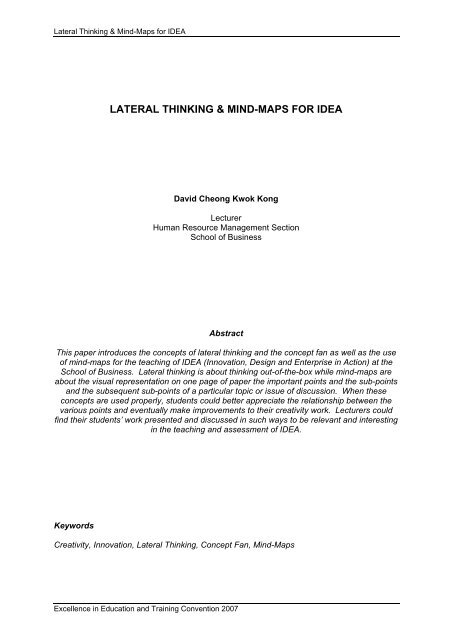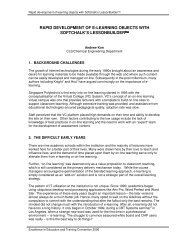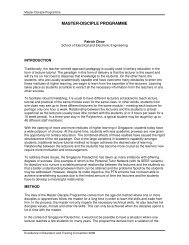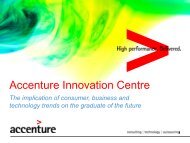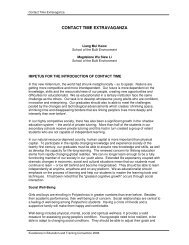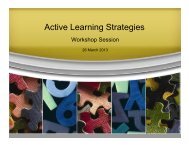Three Competency-based Assignments - ESD Home - Singapore ...
Three Competency-based Assignments - ESD Home - Singapore ...
Three Competency-based Assignments - ESD Home - Singapore ...
You also want an ePaper? Increase the reach of your titles
YUMPU automatically turns print PDFs into web optimized ePapers that Google loves.
Lateral Thinking & Mind-Maps for IDEA<br />
LATERAL THINKING & MIND-MAPS FOR IDEA<br />
David Cheong Kwok Kong<br />
Lecturer<br />
Human Resource Management Section<br />
School of Business<br />
Abstract<br />
This paper introduces the concepts of lateral thinking and the concept fan as well as the use<br />
of mind-maps for the teaching of IDEA (Innovation, Design and Enterprise in Action) at the<br />
School of Business. Lateral thinking is about thinking out-of-the-box while mind-maps are<br />
about the visual representation on one page of paper the important points and the sub-points<br />
and the subsequent sub-points of a particular topic or issue of discussion. When these<br />
concepts are used properly, students could better appreciate the relationship between the<br />
various points and eventually make improvements to their creativity work. Lecturers could<br />
find their students’ work presented and discussed in such ways to be relevant and interesting<br />
in the teaching and assessment of IDEA.<br />
Keywords<br />
Creativity, Innovation, Lateral Thinking, Concept Fan, Mind-Maps<br />
Excellence in Education and Training Convention 2007
Lateral Thinking & Mind-Maps for IDEA<br />
Table of Contents<br />
1: Designing effective and innovative learning environments<br />
1.1. Learning needs of targeted groups of students 3<br />
1.2. Methods and learning resources create novel and effective<br />
teaching strategies 4<br />
1.3 Opportunities for students to apply, practise and demonstrate their<br />
knowledge and skills learned through various modalities 5<br />
2: Using effective and innovative teaching and learning strategies<br />
2.1 Explaining and demonstrating to students the relevance of specific<br />
learning and its connections with other topics/disciplines 7<br />
2.2. Involving students in establishing learning plans and strategies 7<br />
2.3 Positive beliefs and expectations of success amongst students 8<br />
2.4 Analysis and evaluation of student learning and adjustment of<br />
learning arrangements and pedagogic strategies where necessary 8<br />
3: Designing assessment strategies and methods that promote understanding<br />
competence<br />
3.1 Assessment strategies for valid assessment of understanding and<br />
competence in cost-effective ways 7<br />
3.2 Evaluation of the effectiveness of assessment strategies and methods<br />
for understanding and competence 11<br />
List of references 13<br />
Acknowledgements 13<br />
Copyright statement 13<br />
Excellence in Education and Training Convention 2007
Lateral Thinking & Mind-Maps for IDEA<br />
1: DESIGNING EFFECTIVE AND INNOVATIVE LEARNING ENVIRONMENTS<br />
1.1 Learning needs of targeted groups of students<br />
My project shall focus on the Innovation, Design and Enterprise in Action (IDEA)<br />
module taught at the School of Business (SB) where I am the module coordinator (MC).<br />
IDEA is an institutional module and it is therefore a compulsory module for all year-one<br />
students. The synopsis of IDEA is as follows:<br />
“The module develops in our students an attitude for basic creativity, design, literacy,<br />
innovation & enterprise, through an understanding of the design process. This experiential<br />
project-<strong>based</strong> learning module will enable students to question their preconceptions, see<br />
things from multiple perspectives, generate new ideas, make these new ideas work, develop<br />
visual & verbal presentation, and develop a business scenario to sell their ideas to others to<br />
create new uses and lifestyles. Students will be assessed through critique sessions on their<br />
ability to design, make, and develop visual and verbal presentations to sell their ideas and<br />
projects.” Ref: IDEA Centre, <strong>Singapore</strong> Polytechnic, AY2004/2005 Prospectus.<br />
The learning needs of this huge cohort of students are immense and diverse. Many of<br />
them do not have an inkling of what creativity is all about. Perhaps in some work assigned to<br />
students in primary and secondary school, teachers could have encouraged them to be<br />
creative but students in <strong>Singapore</strong>, in general, do not possess a creative culture. Hence,<br />
from an educator’s point of view, one could ask whether students could be instructed and<br />
provided with a curriculum and an environment geared towards creativity in their secondary<br />
and primary schools.<br />
In any case, when these students come to <strong>Singapore</strong> Polytechnic (SP), we are faced<br />
with this enormous task to get them to be creative. They need to be creative because the<br />
country needs such people. LG (NS) Lim Chuan Poh, Permanent Secretary, Ministry of<br />
Education, said at the Educational Research Association of <strong>Singapore</strong> (ERAS) Conference,<br />
24 November 2004:<br />
“Our young must be prepared for a more dynamic and unpredictable future that is fluid,<br />
borderless and highly competitive. They must learn to think for themselves, use their<br />
imagination, be prepared to try and have the resilience to bounce back when they suffer<br />
setbacks. These are the Innovation and Enterprise attributes that we want our students to<br />
have and which we know will stand them in good stead for the future.”<br />
IDEA is an institutional module which is developed and coordinated by the IDEA<br />
Centre at SP. When the IDEA module was first taught, Ontography was used to get students<br />
to be creative. This is about getting students to draw freely on a blank piece of paper<br />
according to their intuition and without thinking. Some of the instructions given by the IDEA<br />
Centre were: “Relax and listen to music if you want. Stop your thoughts. Do not judge. Do<br />
not think. Do not form mental pictures. When the tutor tells you, pick up your pen. Rest<br />
your pen onto the tracing paper. Let the pen move with the music. Do not control the pen.<br />
Let the pen move by itself. Do not judge. Do not think. Do not close your eyes. Your eyes<br />
must remain open. Look at the lines in front of you.”<br />
Subsequently, students were told to create a 3-Dmodel and some of the given<br />
instructions were: Look at your ontography drawing. Use white clay or plasticine to make the<br />
ontography 3-dimensional. Make each piece like a line or a form in your drawing and slowly<br />
join these parts together. Imagine as you make what is behind each line and form in the<br />
drawing. Soon you will have your 3-D ontographic model.”<br />
Excellence in Education and Training Convention 2007
Lateral Thinking & Mind-Maps for IDEA<br />
Such work led students to the IDEA project, which was creating a new product or<br />
service and to set-up a business with it. Some of the given instructions were: “Look at your<br />
ontography drawing and model – and ask the ‘What if?’ question and see if you could allow<br />
the ontography drawing and model help you develop the new product or service – use your<br />
imagination – develop a story if you want to. ‘What if your ontography could serve a<br />
purpose?’ That is, for what purpose will the group’s product or service serve ultimately?”<br />
The above instructions were rather abstract and many students at SB had difficulty.<br />
Perhaps, ontography is more suited to the architectural and engineering students. Many<br />
students have no idea of creativity, and this is the first time they had come into contact with<br />
the term. That they need to be creative for their own and <strong>Singapore</strong>’s future is undeniable<br />
and indisputable. But, surely something can be done to address the students’ learning<br />
needs in relation to creativity. As I was appointed the MC, I felt I had the responsibility to<br />
adapt IDEA to suit SB’s requirements.<br />
1.2 Methods and learning resources create novel and effective teaching strategies<br />
I began to read up and research on creativity. First, I read the works of Edward Be<br />
Bono, a Rhodes scholar at Oxford. Of all his lateral thinking tools and techniques, I found<br />
“The Concept Fan” to be applicable for IDEA students at SB because it is simple and useful.<br />
Next, I read the works of Tony Buzan, who has double honours in Psychology, English,<br />
Mathematics, and the General Sciences from the University of British Columbia. Of all his<br />
works, I found Mind Maps at Work to be applicable for IDEA students at SB because they<br />
give students a visual display of the development of their work.<br />
I read the paper written and presented by Dennis Sale at the ERAS Conference of<br />
November 2004 entitled, “What Creative Teachers Do and How They Do It: a Neurolinguistic<br />
Programming (NLP) Approach”. I found the following extracts from his paper useful and<br />
relevant:<br />
“Firstly, NLP is concerned with modelling effective abilities and transferring these abilities to<br />
others. Secondly, NPL places a strong emphasis on being able to understand the syntax of<br />
individuals’ communication strategies through careful observation, listening and questioning<br />
– ‘sensory acuity’ in NLP terminology. Thirdly, the concept of ‘reframing’, which refers to<br />
putting things in different contexts (frames or reference), thus giving them different meanings,<br />
is in many ways the essence of creative thinking.”<br />
Finally, I read the paper written and presented by Gina Wisker at the ERAS<br />
Conference of November 2004 entitled, “Nurturing and Harnessing Creativity: Lessons from<br />
the Humanities for Innovation and Enterprise”. I found the following extracts from her paper<br />
interesting:<br />
“Creativity is important for all of us and the future of our societies for three reasons:<br />
1. It expands the potential of the whole person emotionally, psychologically, cognitively –<br />
releasing it into action.<br />
2. Nurturing and harnessing creative thinking and practices help us to transfer these<br />
abilities to solve a range of problems in business and professional life as well as personal<br />
development.<br />
3. Economically it is invaluable as the source of new ideas and forms, solutions to problems.<br />
Creative outputs contribute to national and personal financial security. The arts and<br />
humanities – the home base of creativity – themselves generate a great deal of jobs and<br />
gross national product.”<br />
Excellence in Education and Training Convention 2007
Lateral Thinking & Mind-Maps for IDEA<br />
1.3 Opportunities for students to apply, practise and demonstrate their knowledge<br />
and skills learned through various modalities<br />
To guide SB students on the road to creativity, I provided them the following:<br />
Lateral thinking<br />
Lateral thinking is about seeking to solve problems by unorthodox methods. With<br />
“vertical thinking”, you take a position and then you seek to build on that basis. The next step<br />
depends on where you are at this moment. The next step has to be related and logically<br />
derived from where you are at this moment. This suggests building up from a base. With<br />
lateral thinking, we move “sideways” to try different perceptions, different concepts, and<br />
different points of entry. We can use various methods to get us out of our usual line of<br />
thought. There are various lateral thinking tools and techniques.<br />
The concept fan is one of them and it is appropriate as an introduction for students to<br />
lateral thinking. The purpose of the concept fan is to provide a framework for generating<br />
alternative ideas. The framework forces the alternatives by providing a succession of fixed<br />
points. At the right end of the concept fan, we have the purpose or objective of thinking.<br />
Moving backwards from the purpose, we have “directions”, which are very broad approaches.<br />
The broadest approach you can conceive becomes the direction. Next to the left is<br />
“concepts”, which are general methods or ways of doing something. At the extreme left, we<br />
have “ideas”, which are specific concrete ways of putting a concept to work. An idea must be<br />
specific. It must be possible to put an idea directly into practice. Students could generate a<br />
lot of creative ideas in this manner.<br />
(Adapted from: Edward De Bono, “Serious Creativity: Using the Power of Lateral Thinking to<br />
Create New Ideas”, 1993)<br />
An example of my students’ concept fan is as follows:<br />
Ideas<br />
Concepts<br />
Directions<br />
Purpose<br />
WW3 (World War 3)- It is an outdoor game that<br />
allows player to take full control just like being in<br />
the combat field with the help of some equipment.<br />
E-Games<br />
3D suit- Connecting the suit to television enable<br />
consumer to be in the television programme and it<br />
could projects the actions consumer perform into<br />
the programme.<br />
Entertainment<br />
3D headset- Able to see, hear and sense the<br />
presence of the person that you wish to see.<br />
GOT (Going Out Together)- Individuals whose<br />
friends did not turn up for the date can call this<br />
“GOT” organisation to help them arrange a “meet a<br />
new friend session” for tea or something.<br />
3D<br />
Devices<br />
Gathering<br />
How to<br />
reduce<br />
loneliness?<br />
“Individuals” Club House- An emotion detector<br />
will be place the main door.<br />
‘RRR’ (Residents Recreational Room)- It is a<br />
room in which residents can spend their time chit<br />
chatting there or having some board games.<br />
E-Services<br />
Services<br />
Excellence in Education and Training Convention 2007
Lateral Thinking & Mind-Maps for IDEA<br />
Mind maps<br />
A mind map is a visual form of note-taking that can be worked on by one person or a<br />
team of people. At its heart is a central idea or image. This is then explored by means of<br />
branches representing main ideas, which all connect to this central idea. From every “main<br />
idea” branch, there are “sub-idea” branches, which explore themes in greater depth. Just as<br />
the branches are all connected, so are all the ideas in relation to each other, and this gives a<br />
mind map a depth and breadth of scope that a simple list of ideas cannot. By working from<br />
the centre outwards, a mind map encourages thoughts to behave in the same way. Soon a<br />
student’s ideas would expand and he could radiate creative thinking.<br />
(Adapted from: Tony Buzan, “Mind Maps at Work: How to be the Best at your Job and still<br />
have Time to Play”, 2004)”<br />
An example of my students’ work is as follows:<br />
Saves cost<br />
Encourage energy<br />
conservation<br />
How to attract<br />
buyers?<br />
How to<br />
highlight<br />
the effectiveness<br />
of the product?<br />
An energy converter<br />
Converts and<br />
saves energy<br />
Act<br />
Think<br />
Environment<br />
How to persuade<br />
buyers to spend<br />
more for an additional<br />
function?<br />
Relate<br />
Sports Energy<br />
Stimulator<br />
Heaviness<br />
Customers<br />
would not<br />
prefer a<br />
bulky<br />
equipment<br />
Sight (appearance)<br />
Feel<br />
Sense<br />
It should be<br />
stylish enough to<br />
attract<br />
sportsman<br />
Convenience<br />
Touch<br />
No sharp points<br />
It serves two<br />
purpose at one go<br />
(sports and<br />
energy)<br />
It is possible that some students could have been taught lateral thinking and mind<br />
maps during secondary school. However, it is unlikely they have been told to use such<br />
techniques for creative and innovative work, and be assessed on the use of such techniques.<br />
Therefore, I went about redesigning IDEA at SB with confidence that students would find it<br />
helpful and useful. As IDEA is a year-one module, students could apply and practise what<br />
they have learnt about creative techniques to other year-one modules and subsequently to<br />
year-two and year-three modules. IDEA is also a flip-flop module at SB, i.e. half of the cohort<br />
of students takes IDEA in semester 1 while the other half takes IDEA in semester 2. This<br />
ability to apply creativity to other modules is relevant as creativity is a generic skill and is also<br />
needed in other fields of learning. For example, Marketing is a year-one module and<br />
students need to be creative in project work. Similarly, Business Law and Business<br />
Development are second and third-year modules respectively and they require students to<br />
be creative in group work.<br />
Excellence in Education and Training Convention 2007
Lateral Thinking & Mind-Maps for IDEA<br />
2: USING EFFECTIVE AND INNOVATIVE TEACHING AND LEARNING<br />
STRATEGIES<br />
2.1 Explaining and demonstrating to students the relevance of specific learning and<br />
its connections with other topics/disciplines<br />
This part could be explained with reference to the 1 st module aim of IDEA, i.e.<br />
“To develop an attitude for, and the literacy and skills in basic design creativity through an<br />
understanding of the design process.”<br />
The IDEA lectures, tutorials, CAs, etc. have been designed to develop in students an<br />
attitude for, and the literacy and skills in basic design creativity and to enable students to<br />
understand the design process, which is the process of creativity, innovation and enterprise.<br />
Basically, this is about showing and guiding students on how to be creative by following a<br />
process. The lectures have been full of concepts and examples, including pictures of<br />
creative products, etc. The tutorials reinforce the lectures and prepare students for the CAs.<br />
The 4 CAs have been rigorous and the assessment criteria clearly stated.<br />
Students learn about creativity, innovation and enterprise as well as the design<br />
process. Following which, students have to apply the concepts to the development of a new<br />
product or service, which is presented in the form of a potential new business. As they have<br />
to write a business proposal, SB students need to apply whatever knowledge they have<br />
acquired in modules such as Principles of Accounting, Fundamentals of Marketing, etc. This<br />
shows the interdisciplinary link between IDEA and the other modules at SB.<br />
2.2 Involving students in establishing learning plans and strategies<br />
With reference to the 3rd module aim of IDEA, i.e. “To enable students to make these<br />
new ideas work with consideration for humane-centred use & experience.”, students could<br />
plan to address this particular module aim. This aim serves to encourage students to think of<br />
the poor and needy in society and to develop ideas to improve their daily lives. Therefore,<br />
their strategy could be to look for opportunities to meet the needs of the weak, elderly, infants,<br />
sick, poor, etc. The IDEA CA project has produced numerous humane-centred student<br />
projects, e.g. MRT safety barriers, better walking stick for the blind, accessory for the elderly,<br />
home sensor for the aged, temperature-sensitive baby feeding spoon, automatic attendancetaking<br />
device for students, better lecture chair for students, better MRT seats, automatic<br />
window cleaners to minimise the risk of domestic maids falling off from high-rise flats while<br />
cleaning windows, better counselling service for the depressed, new water creating device<br />
and storage container, etc.<br />
Students could also plan for profit-making products and services which are driven by<br />
consumers’ needs for status, style, convenience, etc.. This means they can take another<br />
path, i.e. business-centred instead of humane-centred. The majority of projects have such a<br />
theme reflecting the entrepreneurial culture of business students. Students have the<br />
freedom to choose the type of products or services that they wish to develop. This freedom<br />
given to the students is very important and is appreciated by them.<br />
Excellence in Education and Training Convention 2007
Lateral Thinking & Mind-Maps for IDEA<br />
2.3 Positive beliefs and expectations of success amongst students<br />
IDEA CA4 has fulfilled the 4 th module aim of IDEA, i.e. “To enable students to develop<br />
a simple business proposal, visual and verbal presentation to sell and communicate their<br />
new ideas to others for new use, experience and enterprise.” There are business proposal<br />
and A1 panel templates in IDEA Blackboard for students to download and use. In CA4,<br />
students have to do visual and verbal presentations on their new product or service in<br />
relation to their business proposal and A1 panels.<br />
Students are told of the achievements of their seniors at the SP-wide IDEA Challenge<br />
competition (See Table 1) as it could serve to inspire SB-IDEA students to strive for success<br />
at the competition. Their seniors could be good role models for them to emulate the<br />
examples set.<br />
IDEA Challenge Competition<br />
Year Position Team/ Product/<br />
School<br />
Project Service<br />
2004/2005 2nd PRIUS Disposable underwear SB<br />
2004/2005 3 rd Passion Remote home appliance SB/EEE<br />
device<br />
2005/2006 6 th Condemn Glass which does not allow SB<br />
Condense condensation of ice water<br />
2005/2006 9 th RedPod Revolutionary toilet brush SB<br />
Table 1: Results of Past IDEA Challenge Competitions<br />
2.4 Analysis and evaluation of student learning and adjustment of learning<br />
arrangements and pedagogic strategies where necessary<br />
SB IDEA tutors have to comply with the following extract from SB-DQP-122, 5.2 c):<br />
Module Tutors: To provide feedback to students on their performance in each CA. (DQP –<br />
Department Quality Procedure; an ISO requirement)<br />
We give feedback to each group after every CA. The feedback provides an analysis<br />
and evaluation of the group’s performance. Feedback could be critical but they are always<br />
given constructively. If the group acknowledges and responds to the feedback, in almost<br />
every case, there will be significant improvements to the group’s project. This will happen<br />
because the CAs are progressive in nature and each CA builds on the work done in the<br />
previous CA. Some examples of feedback are as follows:<br />
• Explain how your group arrived at such a huge sales projection.<br />
• Your idea is too far fetched to be practical. Can your group be more realistic?<br />
• How can your group be more effective in marketing and distribution?<br />
Such feedback are reliable and effective. In the real business world, the investor<br />
would want answers to the same questions. When the groups do research, discuss and<br />
attempt to answer such questions, their projects show noticeable improvements.<br />
After feedback is provided, the teacher and his students could make some<br />
adjustments to the learning arrangements and the pedagogic strategies, e.g. the teacher<br />
could tailor feedback according to the special efforts of each group instead of a general class<br />
feedback while students could do more group research on identified weaknesses of their<br />
work.<br />
Excellence in Education and Training Convention 2007
Lateral Thinking & Mind-Maps for IDEA<br />
3: DESIGNING ASSESSMENT STRATEGIES AND METHODS THAT PROMOTE<br />
UNDERSTANDING AND COMPETENCE<br />
3.1 Assessment strategies for valid assessment of understanding and competence in<br />
cost-effective ways<br />
In forming the assessment strategies for IDEA at SB, the following principles had to<br />
be considered:<br />
1. The 4 CAs had to address and meet the module aims of IDEA.<br />
2. A specific list of assessment criteria for each CA as the 4 CAs cannot use the same<br />
criteria; each CA is unique and has its own purpose.<br />
3. As I had introduced lateral thinking and the concept fan as well as mind-mapping at SB, I<br />
had to assess their use by students for the CAs.<br />
4. As IDEA is about creativity, I had to give marks for innovativeness and creativity.<br />
5. As IDEA is also about good teamwork, I had to give marks for teamwork and<br />
cohesiveness.<br />
6. For the presentation, it was appropriate to give marks for the group as well as for<br />
individual presentations.<br />
7. When the 3-D model is required, I would give marks for it.<br />
8. When Internet and/or library research is required, I would give marks for it.<br />
9. When peer evaluation is required, I would give marks for it.<br />
10. As CA1 is about ontography and we have to accept it, I did not make any change to its<br />
original assessment criteria.<br />
11. Provide space for general comments by tutor for each CA so that groups could<br />
understand their areas of weaknesses and work towards improving them at the next CA.<br />
12. Each CA is assessed by 2 tutors and the final mark is the average of the 2 tutors’ marks.<br />
Excellence in Education and Training Convention 2007
Lateral Thinking & Mind-Maps for IDEA<br />
Guided by the above principles, I planned the following schedule of IDEA CA<br />
assessments:<br />
Schedule of IDEA (SP0702 & SP0902) Assessments for AY2006/07, Sem 2<br />
All 4 CAs shall be assessed in combined classes unless timetables do not permit.<br />
Both classes are to be together in one media room for the 2 hours per session of<br />
combined CA assessment by 2 tutors.<br />
CA1 or Tut 1 “Ontography of the Land”(10%):<br />
Individual presentation of Ontography and 3-D model (plasticine).<br />
Each student has 2 minutes to present.<br />
Sequence of presentation may follow class register.<br />
Due: T3/W3<br />
CA2 or Tut 2A “The IDEA Project – Creating an Innovative Product/Service” (20%):<br />
Show one Concept Fan of the product/service.<br />
Group Powerpoint presentation of IDEA project.<br />
Each group has 12 minutes to present.<br />
Lots may be drawn in advance to determine sequence of presentation.<br />
Due: T3/W6<br />
CA3 or Tut 2B “The IDEA Project – Making the Innovative Product/Service work”<br />
(30%):<br />
Show two Mind Maps of the product/service.<br />
Show one 3-D model (any material) of product or service.<br />
Group Powerpoint presentation of IDEA project with interim critique session.<br />
Each group has 15 minutes to present and 10 – 15 minutes for interim critique session.<br />
Do a peer evaluation using form given.<br />
Lots may be drawn in advance to determine sequence of presentation.<br />
Due: T3/W10, T3/W11<br />
CA4 or Tut 2C “The IDEA Project – Presenting the Innovative Product/Service”<br />
(30%):<br />
Submit hardcopy of business proposal (use template) by T4/W1.<br />
Group Powerpoint presentation, which includes 2 A1 presentation boards in Powerpoint<br />
format, main points of business proposal, group’s replies to interim feedback in CA3 and<br />
final critique session.<br />
Do NOT print the 2 A1 panels at this stage.<br />
Submit CD with the flwg saved, i.e. PPT presentation, 2 A1 presentation boards (use<br />
template) and business proposal, by T4/W2.<br />
Should a group’s work be chosen for exhibition, etc., the group is then required to print<br />
the 2 A1 panels.<br />
Each group has 15 minutes to present and 10 – 15 minutes for final critique session.<br />
Do a peer evaluation using form given.<br />
Lots may be drawn in advance to determine sequence of presentation.<br />
Due: T4/W1, T4/W2<br />
Class Participation (10%)<br />
Total (100%)<br />
Excellence in Education and Training Convention 2007
Lateral Thinking & Mind-Maps for IDEA<br />
3.2 Evaluation of the effectiveness of assessment strategies and methods for<br />
understanding and competence<br />
Prof Alan MacGregor, DAC External Examiner, May 2006, on IDEA:<br />
There is an impressive degree of creativity being shown by the students and the marking<br />
plans provided by the staff are worthy of particular commendation. Also worthy of special<br />
mention in the IDEA module which also moves students beyond the comfort of rote learning<br />
and develops valuable creative and independence skills. The changes in this module show<br />
how seriously the student feedback system is taken. Perhaps because I am an accountant I<br />
have some difficulty conceptualising moving from a free form drawing to a business concept.<br />
However, I did enjoy reading the sample of final reports which showed real creativity on the<br />
part of the students.<br />
Prof KK Lam, DBIT External Examiner, June 2006, on IDEA:<br />
PBL (Problem-<strong>based</strong> Learning) modules: Currently, 3 modules have been selected to use a<br />
‘hybrid’ PBL method of teaching and learning. This is the first semester that students in the<br />
DBIT are exposed to this method. In PBL, every 2-3 weeks, students are asked to<br />
brainstorm a problem that they are supposed to solve. Then they are expected to<br />
summarize their discussions on a Concept Map or Mind Map. Students learn the skill in the<br />
IDEA module but due to the ‘flip-flop’ arrangement, not all students in year one would have<br />
been exposed to the mind mapping technique.<br />
Recommendation: find ways to ensure that all students are taught this skill since this life-long<br />
skill will also be useful for lecture note-taking.<br />
My reply to his comments in italics, is as follows:<br />
All DBIT students in year 1 will take IDEA module either in semester 1 or 2, i.e. they will be<br />
exposed to the mind-mapping technique incorporated into IDEA in year 1. As MOB and<br />
IDEA are taught in the same semester, students could apply the mind maps learnt in IDEA to<br />
MOB for problem-<strong>based</strong> learning. Students have access to IDEA in Blackboard where all the<br />
teaching materials on mind maps are found. Once the mind-mapping technique has been<br />
learnt, it will be a life-long skill for students. Therefore, it is not necessary to conduct<br />
separate workshops for year-one students on the mind-mapping technique.<br />
Prof Fred Zandpour, DMC External Examiner, November 2006, on IDEA:<br />
I find this particular module and its related project quite visionary. Fostering creativity and<br />
out-of-the-box thinking must be an essential component of any educational program. But, not<br />
all institutions of higher education have genuinely embraced the idea. It seems <strong>Singapore</strong><br />
Polytechnic is quite serious about the issue and has found a method of doing just that. I<br />
think the aims of the module are quite appropriate and using project is probably the best<br />
method of teaching this module. However, I have a few concerns: I am not quite sure if<br />
students can fully benefit from this project in their first year! Perhaps, students will be better<br />
equipped in terms of conceptual and practical skills to complete this project during their last<br />
year! In addition, I believe there has to be a little focus and direction for the project. For<br />
example, media and communication students may be asked to come up with new business<br />
models in digital media, advertising, online shopping and similar services as opposed to<br />
heavily focusing on product design and development.<br />
Excellence in Education and Training Convention 2007
Lateral Thinking & Mind-Maps for IDEA<br />
My reply, which was approved by Director SB, to his comments in italics, was as follows:<br />
IDEA is a first year module poly-wide and it is an institutional module. DMC year-one<br />
students have benefited from IDEA although it varies from student to student and a lot<br />
depends on the student's attitude towards creativity in business. There are no plans by the<br />
SP-IDEA team at this juncture to shift IDEA to the third year.<br />
The IDEA project (given as a handout at the start of semester to lecturers and students)<br />
clearly states that "the task is to design a new experience of your product or service." The<br />
description of the 3 CAs, included in IDEA Project handout, clearly indicates product or<br />
service:<br />
CA2: "The IDEA Project - Creating an Innovative Product/Service"<br />
CA3: "The IDEA Project - Making an Innovative Product/Service Work"<br />
CA4: "The IDEA Project - Enterprise - Presenting an Innovative Product/Service"<br />
Over the past 6 semesters that IDEA had been taught to DMC, DBA, DAC, DBF, DBIT and<br />
DTRM, there have been various service projects done by our students. DMC students are<br />
free to come up with new business models in digital media, advertising, online shopping and<br />
similar services. In fact, I have encouraged my IDEA-DMC classes to consider applying<br />
IDEA to their media and communication course. So far, most of the IDEA-DMC projects<br />
have been about new products. Eventually with further encouragement from lecturers, some<br />
of the IDEA-DMC projects could revolve around media and communication services.<br />
Excellence in Education and Training Convention 2007
Lateral Thinking & Mind-Maps for IDEA<br />
References<br />
1. Edward De Bono, “Serious Creativity: Using the Power of Lateral Thinking to Create<br />
New Ideas”, 1993<br />
2. Tony Buzan, “Mind Maps at Work: How to be the Best at your Job and still have Time<br />
to Play”, 2004<br />
3. LG (NS) Lim Chuan Poh, Permanent Secretary, Ministry of Education, Keynote<br />
Address at the Educational Research Association of <strong>Singapore</strong> (ERAS) Conference, 24<br />
November 2004<br />
4. Dennis Sale’s paper at the ERAS Conference of November 2004 entitled, “What<br />
Creative Teachers Do and How They Do It: a Neurolinguistic Programming (NLP)<br />
Approach”<br />
5. Gina Wisker’s paper at the ERAS Conference of November 2004 entitled, “Nurturing<br />
and Harnessing Creativity: Lessons from the Humanities for Innovation and Enterprise”<br />
6. IDEA synopsis: IDEA Centre, <strong>Singapore</strong> Polytechnic, AY2004/2005, Prospectus<br />
Acknowledgements<br />
I wish to acknowledge Mr Dennis Sale’s encouragement and support in this work of<br />
mine. When I first met him to discuss my project in his office, he was very kind and<br />
understanding to give me the support to introduce lateral thinking and mind-mapping to help<br />
students at the School of Business, <strong>Singapore</strong> Polytechnic, in coming up with creative ideas<br />
for new products and services.<br />
My Director SB’s support was also instrumental to my role as module coordinator for<br />
IDEA at SB where all that I have written in this report took place. I feel my work has been<br />
useful as the feedback from the Professors, who were the external examiners for the various<br />
diplomas, as well as student feedback were satisfactory. However, I must admit that there<br />
are still areas for improvement in the quest to teach 17-year old students in <strong>Singapore</strong><br />
Polytechnic to be creative in business.<br />
Copyright Statement<br />
Copyright © 2004 David Cheong Kwok Kong: The author assigns to <strong>Singapore</strong> Polytechnic<br />
and educational non-profit institutions a non-exclusive licence to use this document for<br />
personal use and in courses of instruction provided that the article is used in full and this<br />
copyright statement is reproduced. Any other usage is prohibited without the express<br />
permission of the author.<br />
Excellence in Education and Training Convention 2007


